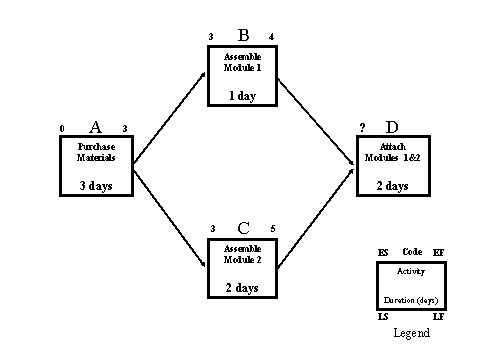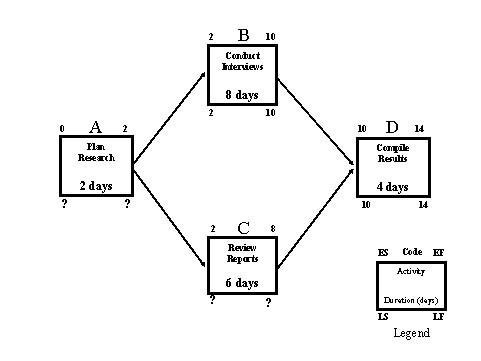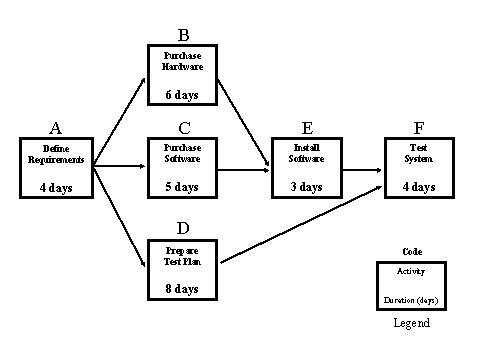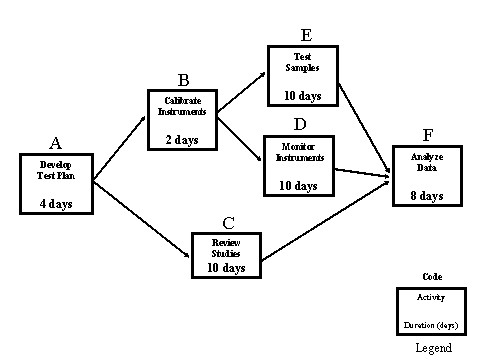Scheduling projects chapter 7
Chapter 7 - Scheduling Projects
TRUE/FALSE
- In order for activities to be useful as schedule building blocks, they should have tangible output that can be verified.
ANS: T DIF: Average REF: Intro
- There is often terrific pressure to complete a project as quickly as possible. To confront this pressure, a project manager should quickly promise to meet the deadlines requested by the sponsor and then assemble a team to create the corresponding schedule.
ANS: F DIF: Average REF: 7.4
- The first process in developing a project schedule is to identify all the resources available to work on the project.
ANS: F DIF: Challenging REF: 7.5
- While the lowest level of decomposition in a Work Breakdown Structure is the work package, work packages can still be decomposed further into project activities.
ANS: T DIF: Average REF: 7.5
- Except in rare circumstances, project teams should not attempt to decompose work packages into project activities because work packages provide sufficient detail to develop a project schedule.
ANS: F DIF: Challenging REF: 7.5
- A successor activity follows a predecessor activity based on their logical relationship.
ANS: T DIF: Easy REF: 7.6
- The most common type of logical dependency to determine the sequence of project activities is “finish-to-finish”.
ANS: F DIF: Average REF: 7.6
- The “start-to-start” logical relationship used in activity sequencing applies to the case where initiation of the successor activity depends upon initiation of the predecessor activity.
ANS: T DIF: Average REF: 7.6
- The length of time to perform an activity is often dependent upon who will do that work.
ANS: T DIF: Easy REF: 7.7
- Prioritizing projects and carefully authorizing the start of non-critical activities can serve as remedies for multi-tasking.
ANS: T DIF: Challenging REF: 7.7
- The critical path is the sequence of activities that form the shortest path through the project network and determine the duration of the project.
ANS: F DIF: Average REF: 7.8
- If a project manager delays the start of an activity on the critical path, then the expected completion date of the project will occur at a later date than originally planned.
ANS: T DIF: Average REF: 7.8
- The enumeration method of determining the critical path relies upon identification of all paths through the project network.
ANS: T DIF: Average REF: 7.8
- When developing a project schedule, slack refers to the time between the start and the finish of a planned activity.
ANS: F DIF: Challenging REF: 7.8
- Even small delays on “near-critical” activities can change the critical path of a project.
ANS: T DIF: Average REF: 7.8
- PERT refers to the Program Evaluation and Review Technique which was developed to better understand how variability in the duration of individual activities impacts the expected project duration.
ANS: T DIF: Average REF: 7.9
- GANTT refers to the Generalized Activity Network Tracking Technique which was developed to better understand how variability in the duration of individual activities impacts the expected project duration.
ANS: F DIF: Easy REF: 7.9
- The primary advantage of PERT is that it removes uncertainty from the estimates of activity durations, thereby increasing confidence in the reliability of a project schedule.
ANS: F DIF: Challenging REF: 7.9
- Monte Carlo Analysis is a technique that computes activity durations based on three time estimates: one optimistic, one pessimistic and one most likely.
ANS: F DIF: Easy REF: 7.9
- A Gantt chart is a tool that can be used to communicate a project schedule.
ANS: T DIF: Easy REF: 7.10
MULTIPLE CHOICE
- Estimating the number of work periods that will be needed to complete individual schedule activities characterizes which of the following time management processes?
|
a. |
activity definition |
|
b. |
activity sequencing |
|
c. |
activity duration estimating |
|
d. |
none of these |
ANS: C DIF: Average REF: 7.1
- Creating a realistic schedule is often an iterative process because several factors can limit how fast a project can be completed. Which of the following factors can limit how fast a project can be scheduled and completed?
|
a. |
logical order |
|
b. |
imposed dates |
|
c. |
resource availability |
|
d. |
all of these |
ANS: D DIF: Average REF: 7.4
- Faced with significant schedule challenges, the project manager has several responsibilities. Which of the following are among the project manager’s responsibilities?
|
a. |
determine a feasible schedule |
|
b. |
persuade all stakeholders that the schedule makes sense |
|
c. |
deliver the project according to the agreed-upon schedule |
|
d. |
all of these |
ANS: D DIF: Average REF: 7.4
- Which of the following items can provide useful assistance to a project team to define the activities of a project?
|
a. |
the work packages from the Work Breakdown Structure |
|
b. |
schedules from similar projects that are already completed |
|
c. |
checklists for projects of the same type |
|
d. |
all of these |
ANS: D DIF: Easy REF: 7.5
- Milestones are important points in a project schedule that can serve as check points for project managers and sponsors. Which of the following reasons might justify the decision to establish a milestone?
|
a. |
completion of a major deliverable |
|
b. |
a pending decision to commit a large amount of money |
|
c. |
a merging point where multiple activities must be completed before progress can continue |
|
d. |
all of these |
ANS: D DIF: Challenging REF: 7.5
- A scheduled activity that determines when a logical successor activity can begin and end is known as:
|
a. |
a catalyst activity |
|
b. |
a predecessor activity |
|
c. |
a leader activity |
|
d. |
none of these |
ANS: B DIF: Average REF: 7.6
- The sequencing of activities is often based upon dependencies between the activities. The dependencies that should guide activity sequencing can be either:
|
a. |
mandatory or discretionary |
|
b. |
arbitrary or capricious |
|
c. |
logical or illogical |
|
d. |
none of these |
ANS: A DIF: Easy REF: 7.6
- Which of the following responses identifies a common type of logical dependency used to sequence project activities?
|
a. |
first-in; first-out |
|
b. |
last-in; last-out |
|
c. |
finish-to-start |
|
d. |
all of these |
ANS: C DIF: Average REF: 7.6
- The total number of work periods (not including holidays or other non-work time) required to complete a schedule activity is known as:
|
a. |
effort |
|
b. |
elapsed time |
|
c. |
duration |
|
d. |
none of these |
ANS: C DIF: Easy REF: 7.7
- Which of the following strategies can help a project team to develop realistic time estimates for project activities?
|
a. |
verify the time estimates with the people doing the work |
|
b. |
be sure to consider learning curves, interruptions and competing priorities |
|
c. |
adjust estimates from previous projects to account for differences |
|
d. |
all of these |
ANS: D DIF: Average REF: 7.7
- Which of the following problems contributes to difficulty in estimating activity durations accurately?
|
a. |
merging - the case of multiple predecessors |
|
b. |
omissions - leaving out key activities |
|
c. |
general uncertainty in the estimate |
|
d. |
all of these |
ANS: D DIF: Average REF: 7.7
- Which of the following remedies may reduce the likelihood of omissions when developing activity duration estimates.
|
a. |
staggered project start dates |
|
b. |
resource buffers |
|
c. |
checklists, templates, WBS |
|
d. |
all of these |
ANS: C DIF: Average REF: 7.7
- Which of the following statements correctly describes the critical path?
|
a. |
It is the shortest sequence of activities through the project network. |
|
b. |
It determines the latest possible end date of the project. |
|
c. |
It consists only of activities with zero slack. |
|
d. |
all of these |
ANS: C DIF: Average REF: 7.8
- The total amount of time a schedule activity may be delayed from its early start date without delaying the project finish date is known as:
|
a. |
reserve |
|
b. |
slack |
|
c. |
contingency |
|
d. |
none of these |
ANS: B DIF: Average REF: 7.8
- Despite the insights that PERT provides, there are still practical limitations that impact its usefulness. Which of the following difficulties are associated with the use of PERT?
|
a. |
It often requires more effort to generate three estimates than one. |
|
b. |
There is no assurance that three estimates are any more accurate than one. |
|
c. |
It does not accurately address the case when two activities both need to be accomplished before a third can begin. |
|
d. |
all of these |
ANS: D DIF: Challenging REF: 7.9
- Which of the following statements correctly describes an advantage or disadvantage associated with the use of Monte Carlo Analysis?
|
a. |
The flexibility of Monte Carlo Analysis allows for more realistic estimates. |
|
b. |
Monte Carlo simulation aids in the identification of near-critical paths. |
|
c. |
Monte Carlo simulations typically require the use of special software and skills. |
|
d. |
all of these |
ANS: D DIF: Average REF: 7.9

Figure 7-1 Assembly Project |
- Consider the Assembly Project depicted in Figure 7-1. Based on the information provided, what is the early start date for activity D - “Attach Modules 1 & 2”?
|
a. |
Day 0 |
|
b. |
Day 3 |
|
c. |
Day 4 |
|
d. |
Day 5 |
ANS: D DIF: Average REF: 7.8

Figure 7-2 Research Project |
- Consider the Research Project depicted in Figure 7-2. Based on the information provided, what is the late start date for activity C - “Review Reports”?
|
a. |
Day 0 |
|
b. |
Day 2 |
|
c. |
Day 4 |
|
d. |
Day 10 |
ANS: C DIF: Average REF: 7.8
- Consider the Research Project depicted in Figure 7-2. Based on the information provided, what is the late start date for activity A - “Plan Research”?
|
a. |
Day 0 |
|
b. |
Day 2 |
|
c. |
Day 4 |
|
d. |
Day 10 |
ANS: A DIF: Average REF: 7.8
- Consider the Research Project depicted in Figure 7-2. Based on the information provided, which activity can you delay by one day without impacting the expected completion date for the project?
|
a. |
Activity A |
|
b. |
Activity B |
|
c. |
Activity C |
|
d. |
Activity D |
ANS: C DIF: Average REF: 7.8
- Consider the Research Project depicted in Figure 7-2. Based on the information provided, what is the slack associated with activity C - “Review Reports”?
|
a. |
0 days |
|
b. |
1 day |
|
c. |
2 days |
|
d. |
4 days |
ANS: C DIF: Average REF: 7.8

Figure 7-3 System Integration Project |
- Consider the System Integration Project depicted in Figure 7-3. Based on the information provided, what is the expected duration of this project?
|
a. |
15 days |
|
b. |
16 days |
|
c. |
17 days |
|
d. |
30 days |
ANS: C DIF: Average REF: 7.8
- Consider the System Integration Project depicted in Figure 7-3. Based on the information provided, which activities constitute the critical path for this project?
|
a. |
A-B-E-F |
|
b. |
A-C-E-F |
|
c. |
A-D-E-F |
|
d. |
A-D-F |
ANS: A DIF: Average REF: 7.8
- Consider the System Integration Project depicted in Figure 7-3. Based on the information provided, which activities can be delayed one day without impacting the expected project completion date?
|
a. |
Activity E - Install Software and Activity F - Test System |
|
b. |
Activity C - Purchase Software and Activity E - Install Software |
|
c. |
Activity C - Purchase Software and Activity D - Prepare Test Plan |
|
d. |
none of these |
ANS: C DIF: Challenging REF: 7.8
- Consider the System Integration Project depicted in Figure 7-3. Based on the information provided, how many days can you delay the purchase of software (Activity C), without impacting the expected project completion date?
|
a. |
0 days |
|
b. |
1 day |
|
c. |
2 days |
|
d. |
4 days |
ANS: B DIF: Challenging REF: 7.8

Figure 7-4 Lab Experiment Project |
- Consider the Lab Experiment Project depicted in Figure 7-4. Based on the information provided, what is the expected duration of this project?
|
a. |
22 days |
|
b. |
24 days |
|
c. |
26 days |
|
d. |
28 days |
ANS: B DIF: Average REF: 7.8
- Consider the Lab Experiment Project depicted in Figure 7-4. Based on the information provided, identify the critical path(s) for this project?
|
a. |
A-C-F only |
|
b. |
A-B-D-F only |
|
c. |
A-B-E-F only |
|
d. |
Both A-B-D-F and A-B-E-F are critical paths |
ANS: D DIF: Challenging REF: 7.8
- Consider the Lab Experiment Project depicted in Figure 7-4. Based on the information provided, which activity can be delayed one day without impacting the expected project completion date?
|
a. |
Activity B - Calibrate Instruments |
|
b. |
Activity C - Review Studies |
|
c. |
Activity D - Monitor Instruments |
|
d. |
Activity E - Test Samples |
ANS: B DIF: Average REF: 7.8
- Consider the Lab Experiment Project depicted in Figure 7-4. Based on the information provided, how many days can you delay the calibration of the instrumentation (Activity B), without impacting the expected project completion date?
|
a. |
0 days |
|
b. |
1 day |
|
c. |
2 days |
|
d. |
4 days |
ANS: A DIF: Challenging REF: 7.8
|
Activity |
Optimistic Time (a) |
Most Likely Time (m) |
Pessimistic Time (b) |
Expected Duration |
|
A - Review Design |
18 |
24 |
30 |
24 |
|
B - Assemble Item |
14 |
21 |
28 |
21 |
|
C - Inspect Item |
4 |
6 |
8 |
6 |
|
D - Package Item |
5 |
10 |
12 |
? |
|
Figure 7-5 Duration Estimates | ||||
- Consider the activity duration estimates presented in Figure 7-5. Based on the information provided and adopting the PERT conventions to calculate expected activity durations, what is the expected duration of Activity D - “Package Item”?
|
a. |
9 days |
|
b. |
9.5 days |
|
c. |
10 days |
|
d. |
12 days |
ANS: B DIF: Challenging REF: 7.9
|
Activity |
Predecessor(s) |
Duration (days) |
|
A |
--- |
5 |
|
B |
A |
20 |
|
C |
A |
15 |
|
D |
A |
5 |
|
E |
B, C |
60 |
|
F |
D |
15 |
|
G |
E |
20 |
|
H |
E |
15 |
|
I |
F, G, H |
2 |
|
Figure 7-6 Network Scheduling Data | ||
- Consider the network scheduling data provided in Figure 7-6. Which activities constitute the critical path for this project network?
|
a. |
A-D-F-I |
|
b. |
A-C-E-H-I |
|
c. |
A-B-E-H-I |
|
d. |
A-B-E-G-I |
ANS: D DIF: Challenging REF: 7.8
- Consider the network scheduling data provided in Figure 7-6. What is the expected duration of this project?
|
a. |
97 days |
|
b. |
102 days |
|
c. |
107 days |
|
d. |
112 days |
ANS: C DIF: Challenging REF: 7.8
- Consider the network scheduling data presented in Figure 7-6. How many days of slack are associated with activity F?
|
a. |
0 |
|
b. |
15 |
|
c. |
80 |
|
d. |
107 |
ANS: C DIF: Challenging REF: 7.8
ESSAY
- Projects are often completed late. Describe the techniques you would use as a project manager to improve the accuracy and reliability of your project schedule.
ANS: Answers will vary.
DIF: Challenging
- Describe “slack” and how you can use slack to your advantage in managing a project.
ANS: Answers will vary.
DIF: Challenging
- Describe how you would use the members of your project team to develop and execute a project schedule.
ANS: Answers will vary.
DIF: Challenging


